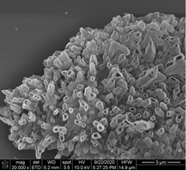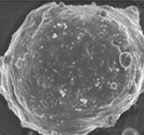“A prototype for synthesis of new on-board hydrogen storage materials (HSMs) has been developed by our team. The hydrogen storage capacity of HSMs have been improved by optimizing the preparation and purification procedures and improving the volumetric and gravimetric capacities, hydrogen adsorption/desorption kinetics, cycle life, and reaction thermodynamics of potential material candidates.
HSMs for solid-state hydrogen storage applications, have been fabricated which have hydrogen storage gravimetric capacity of 1.17 wt.% (KgH2/Kg materials mass) for carbonous nanomaterials at room temperature and 8.2 wt.% (KgH2/Kg materials mass) for porous nanomaterials at 150 °C at relatively low pressure (≤ 40 bar).
We are optimizing our hydrogen storage technology to increase the yield and purity of HSMs to achieve large-scale production of related products, reduce cost and improve the efficiency.”
Carbon-based Nanostructures
-
Carbon-based nanotubes have been a popular candidate as the sorbent for solid-state hydrogen storage due to the low density, high surface area, and high stability properties. The nanotube structure provides storage sites for hydrogen atoms.
Composite and Porous Thin Films
-
A new porous material for the hydrogen storage has been developed by our team that showed superior hydrogenation properties as it stores hydrogen in porous structure during fabrication by electrochemical etching of hydrofluoric acid. The material indicated high specific surface area and high chemical activity with hydrogen. Recent breakthroughs from our group in porous materials included that addition of catalyst by Spillover effect resulted in increase of the yield of samples per fabrication batch.






